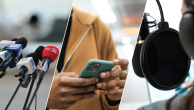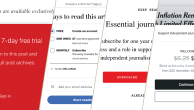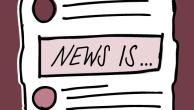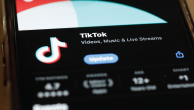Summary of Findings

Public attitudes toward the press, which have been on a downward track for years, have become more negative in several key areas. Growing numbers of people question the news media’s patriotism and fairness. Perceptions of political bias also have risen over the past two years.
Yet despite these criticisms, most Americans continue to say that they like mainstream news outlets. By wide margins, more Americans give favorable than unfavorable ratings to their daily newspaper (80%-20%), local TV news (79%-21%), and cable TV news networks (79%-21%), among those able to rate these organizations. The margin is only slightly smaller for network TV news (75%-25%).
In fact, the favorable ratings for most categories of news organizations surpass positive ratings for President Bush and major political institutions the Supreme Court, Congress, and the two major political parties. Favorable ratings for daily newspapers, local TV news and network TV news have all remained fairly stable since July 2001, even as public attitudes toward the news media have declined. The exception to this pattern are large, nationally influential newspapers, such as the Washington Post and New York Times, whose favorable ratings have declined markedly.
The latest national survey by the Pew Research Center for the People & the Press, conducted June 8-12 among 1,464 Americans, shows increasing politicization of attitudes toward the news media. Republicans, already more critical than Democrats of the press, have become even more so. Growing numbers of Republicans see the press as too critical of America and hurting democracy. Still, even majorities of Republicans continue to express favorable views of most major news sources.
This is not the first time a Pew Research Center survey has shown the public to be broadly critical of the press, yet still favorable in its overall view of news organizations themselves. In fact, the public has long been two-minded in its views of the news media faulting the press in a variety of ways, while still valuing the news and appreciating the product of news outlets.
In the current polling, those who expressed favorable opinions of daily newspapers, local TV news, network news and cable news struck similar themes in explaining their positive views of these news outlets. Respondents most often cited the fact that they are able to get the news and information they seek in a timely fashion; the breadth of coverage; and the ability to stay informed about a wide range of news developments, both locally and globally.
The latest Pew survey on the news media finds that the sustained growth in online news consumption has implications for overall newspaper readership. Overall, a third of Americans below age 40 cite the internet as their main source of news, and many of these people are reading newspapers online. Consequently, while people under age 50 remain far less likely to read a print newspaper than are older people, they are turning to local and national newspapers online in fairly significant numbers.
The poll also finds that the public makes broad distinctions between fact-based and opinion-oriented news outlets. Roughly six-in-ten Americans (61%) say local TV news programs mostly report facts about recent news developments, rather than opinions; smaller majorities see daily newspapers (54%) and nightly network TV news (53%) as mostly fact-based.

Though cable news networks are no more likely to be described as opinion-oriented than network evening news programs, fewer (45%) describe them as mostly reporting the facts. That also is the case for major national newspapers; while three-in-ten see them as mostly presenting their opinions, 45% say they mostly report the facts.
On the opinion side of the fact-opinion spectrum are talk radio shows and internet news blogs. Just 10% say talk radio shows are mostly fact-oriented; 68% say they mostly give their opinions about the news. Far fewer Americans are familiar with news blogs than other news sources, but on balance, more say blogs are opinion-oriented than fact-based (by 32%-20%).
Favorability vs. Believability

The predominantly favorable ratings given to media organizations stand in contrast not only to how other institutions are rated, but to the credibility Americans associate with these same news outlets.
A survey conducted last year by the Pew Research Center for the People and the Press showed that credibility ratings for most major news outlets had reached a low ebb (see “News Audiences Increasingly Politicized, June 8, 2004). Placing these downward trends in believability side-by-side with the long-term trends in favorability reveals a growing gap.
The gap is most striking between the public’s evaluations of the credibility, and favorability, of their daily newspapers. The percentage saying they can believe most of what they read in their daily newspaper dropped from 84% in 1985 to 54% in 2004. But the number expressing a favorable opinion of their daily newspaper, based on those familiar enough to give a rating, declined just eight points over the same period (from 88% to 80%).
For both network and local TV news, the patterns are similar though somewhat less dramatic. More people feel favorably toward these media organizations than say they can believe what they read, see and hear from these outlets.
Explaining Favorable Opinions
As part of the survey, those who expressed favorable opinions of four major types of news organizations network television news, daily newspapers, local television news, and cable news networks explained what is most appealing about these outlets.1 These interviews reveal that, despite the extensive criticisms of the news media’s performance, people generally are able to find what they seek from these outlets timely information and news coverage. The responses also reveal differences across news audiences in terms of what is most appreciated about each major news source.
Those who expressed positive views of network television news programs most frequently said that these programs do a good job of summarizing the news, and provide a considerable range and breadth of coverage in an understandable fashion. Many respondents also mentioned liking the anchors and reporters.

By contrast, those with a favorable view of the cable news networks most commonly mentioned the timeliness, convenience, and accessibility of the reports available “anytime” in the words of several respondents. Many noted the advantage that the cable news programs have in reporting up-to-the-minute information on breaking stories.
Local television news is popular in large part because it is local. People frequently mentioned that they appreciate the ability to find out what is happening in their communities the “hometown factor” in the words of one respondent. Specific mentions touched on the anchors and their personalities, the weather coverage, and the perceived lack of bias in the news.
Those who have a favorable view of newspapers also praise them for their local quality. But people most often cited various aspects to their content sports scores, classifieds, community features, etc. Several respondents specifically cited the editorial pages as something that they liked about their newspaper, and others also cited a perceived lack of political bias in the paper.
Internet News More Than Just the Young
The internet continues to grow as a source of news for Americans. One-in-four (24%) list the internet as a main source of news. Roughly the same number (23%) say they go online for news every day, up from 15% in 2000; the percentage checking the web for news at least once a week has grown from 33% to 44% over the same time period.
While online news consumption is highest among young people (those under age 30), it is not an activity that is limited to the very young. Three-in-ten Americans ages 30-49 cite the internet as a main source of news.

The importance of the web for people in their working years is even more apparent when the frequency of use is taken into account. One-third of people in their 30s say they get news online every day, as do 27% of people in their 40s. Nearly a quarter of people in their 50s get news online daily, about the same rate as among people ages 18-29.
Online Newspapers
But what of the growing online presence of both national and local newspapers? How important an element are newspapers as part of the overall mix of internet news sources?
The current study includes two measures that provide some insight into this growing news source. First, by a 90%-6% margin, respondents who say they rely on newspapers as a main source almost universally mean the printed version of the paper, not the online version. Second, when respondents cite the internet as a main source, most are including their use of online newspapers. Fully 62% of internet news consumers say they read the websites of local or national newspapers.

Combined, these questions indicate that while 40% of Americans count the printed newspaper as a main source of news, another 16% are reading newspapers as part of their internet news consumption. The relevance of online newspaper readership is most important among younger Americans. While only about a third of those under age 40 count the printed newspaper as a main source of news (compared with half of those age 50 and older), another 20% say the online version is at least a part of their internet use. While younger people tend to consume far less news overall than their seniors, newspapers in one form or another remain a key part of the media mix for majorities in all age groups.
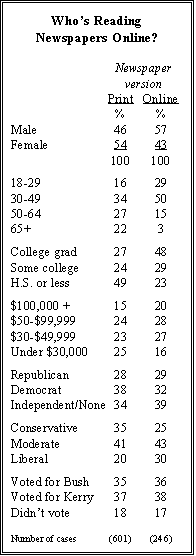
Convenience is more important than cost in explaining why many Americans are reading the paper online instead of in print. Among those who say they read the web-version of the newspaper, 73% cite convenience, compared with just 8% who do so because it is free. Most Americans say they are reading the print version as much (50%) or more often (12%) than they did before they began reading the paper online. But 35% say the printed newspaper is something they look at less often now that they are using newspapers’ websites.
Visitors to newspaper websites are starkly different from print newspaper readers in terms of their demographics, but not their politics. In addition to being much younger than readers of printed newspapers, the online newspaper audience is mostly male, wealthy, and highly educated. Nearly half of web-newspaper readers have college degrees, compared with 27% of those who rely on print, and one-in-five have household incomes of over $100,000.
People who mostly use newspaper websites instead of newspapers are more likely to describe themselves as liberal (30% vs. 20%, respectively), but are no more likely to think of themselves as Democrats, and divided their votes between Bush and Kerry in the 2004 election along almost precisely the same lines as regular newspaper readers.
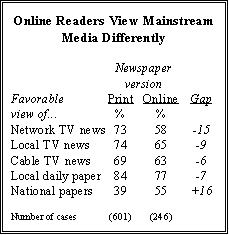
Where the views of online newspaper readers differ more dramatically is in their evaluations of mainstream media organizations. People who read the newspaper online have a far less favorable opinion of network and local TV news programming than do people who read the print version, and also have a somewhat less favorable view of the daily newspaper they are most familiar with. But consumers of online newspapers feel far more favorably toward large nationally influential newspapers, such as the New York Times and the Washington Post.
Ever More Critical
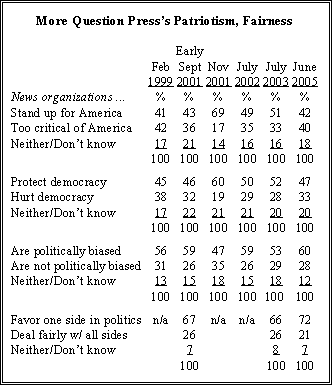
In many cases, attitudes toward the performance of the news media are at or near their low points in Pew trends dating back to the mid-1980s. This is especially the case in opinions regarding the press’s patriotism, bias, and fairness.
Just 42% say news organizations generally “stand up for America;” about as many (40%) believe that news organizations are “too critical of America.” That represents a significant shift since July 2003, when a narrow majority (51%) said that news organizations stand up for America, while 33% said they were too critical.
The percentage who say news organizations are too critical is only slightly below the level reached in February 1999 (42%), during former President Clinton’s impeachment trial.
Other measures assessing the basic values of the press also have become more negative. Six-in-ten see news organizations as politically biased, up from 53% two years ago. More than seven-in-ten (72%) say news organizations tend to favor one side, rather than treat all sides fairly; that is the largest number ever expressing that view. And by more than three-to-one (73%-21%), the public feels that news organizations are “often influenced by powerful people and organizations,” rather than “pretty independent.”

Partisans Differ on Press Problems
Partisanship has long been a major factor in these attitudes. Even so, there has been a startling rise in the politicization of opinions on several measures especially the question of whether the news media stands up for America, or is too critical of America.
The partisan gap on this issue has grown dramatically, as Republicans increasingly express the view that the press is excessively critical of the U.S. (67% now vs. 42% in 2002). Over the same period, Democratic opinions on this have remained fairly stable (24% now vs. 26% in 2002).
Republicans are now closely divided as to whether the press protects or hurts democracy; 40% say it protects democracy, while 43% believe it hurts democracy. Two years ago, by a fairly sizable margin (44%-31%) more Republicans felt that the press helped democracy. Democratic opinion on this measure has been more stable. In the current survey, 56% say the press protects democracy while just 27% say it hurts democracy.
Views on whether the press is politically biased have been more consistent over the years. More than seven-in-ten Republicans (73%) say the press is biased, compared with 53% of Democrats. Perceptions of political bias have increased modestly among members of both parties over the past two years.
Democrats Chide Bush Coverage

Generally, Democrats are much more positive in their assessments of press values and performance than are Republicans. But increasingly, Democrats are showing dissatisfaction with press coverage of the Bush administration. A majority of Democrats (54%) say that press coverage of the Bush administration has not been critical enough; that represents a sizable increase from May 2004 (39%).
An increasing number of independents also believe the press has not been critical enough in its coverage of the Bush’s administration’s policies and performance (38% now vs. 25% last year). A consistent majority of Republicans say that press coverage of the Bush administration has been too critical; 58% express that view, no change from May 2004.

Press’s Influence Waning
In past surveys on the press, criticisms of the news media were accompanied by a widespread perception that the power of news organizations was expanding.
But that has changed, largely owing to a major shift in perceptions among Republicans. Overall, more Americans still believe the influence of the press is increasing rather than decreasing (by 49%-36%), but the margin has narrowed. Two years ago, 55% said news organizations were growing in influence, while just 29% felt their influence was declining.
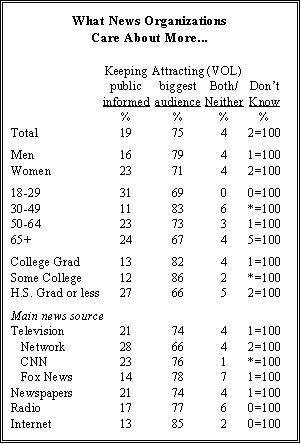
In the past, Republicans by wide margins said that news organizations were growing in influence. But in the current survey, as many say the press is losing influence as say it is expanding in influence (45% vs. 43%). Attitudes among Democrats and independents have been much more stable.
Questioning Press Motives
While there are deep differences about the press’s power and performance, most Americans agree that news organizations, when deciding what stories to report, care more about attracting the biggest audience rather than about keeping the public informed.
Majorities in every demographic and political group express this opinion, but it is especially prevalent among conservative Republicans (90%).
However, even two-thirds of liberal Democrats (67%) say the news media is more motivated by a desire to expand audience than informing the public.
People who have attended college are more likely than high school graduates to say that the press mostly seeks to attract the biggest audience.
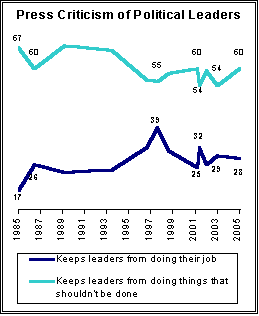
And 85% of those who cite the internet as a main source believe that news organizations are mostly motivated by a desire to expand their audience, rather than to inform the public.
Conflicting Views of Watchdog Roles
Beyond the rising criticism of press performance and patriotism, there also has been significant erosion in support for the news media’s watchdog role over the military. Nearly half (47%) say that by criticizing the military, news organizations are weakening the nation’s defenses; 44% say such criticism keeps the nation militarily prepared. The percentage saying press criticism weakens American defenses has been increasing in recent years and now stands at its highest point in surveys dating to 1985.

By contrast, public support for the news media’s role as a political watchdog has endured and even increased a bit. Six-in-ten Americans say that by criticizing political leaders, news organizations keep political leaders from doing things that should not be done; just 28% feel such criticism keeps political leaders from doing their jobs. Two years ago, 54% endorsed the press’s role as a political watchdog.
The long-term growth in the view that press criticism weakens the military has mostly come among Republicans. From the mid-1980s through the end of the Persian Gulf War in March 1991, minorities of Republicans felt that such criticism weakened the military. Currently, two-thirds of Republicans (67%) express that opinion. Attitudes among Democrats and independents have been far more stable.
While the public has been more consistently supportive of the press’s adversarial role in politics, there has been some partisan movement reflecting the changing balance of power in Washington. In the late 1990s, during the Clinton administration, Republicans were somewhat more likely than Democrats to say that criticism of political leaders was worth it because it could prevent wrongdoing.
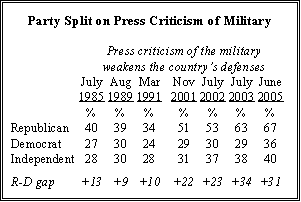
Since then, Democrats have become much more supportive of the news media’s political watchdog role, and Republicans less so.
Neutral Terror Coverage Backed
While the press is taking more heat for its patriotism and performance, the public continues to decisively reject a shift to ‘pro-American’ coverage of the war on terror. By nearly three-to-one (68%-24%), Americans believe it is better if coverage of the war on terror is neutral rather than pro-American.
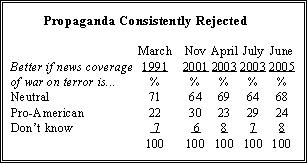
The preference for neutral coverage of the war on terror is shared by majorities across the demographic and political spectrum. However, about four-in-ten conservative Republicans (39%) favor pro-American coverage, the largest percentage in any category.
Split Over Anonymous Sources
The recent revelation of the identity of the press informant known as Deep Throat from the Watergate scandal brought the issue of confidential news sources back into public view. Americans are divided on the general question of whether it is acceptable for news organizations to use unnamed sources in their reporting.
About half (52%) say the use of such sources is too risky because it can lead to inaccurate reports, while 44% say it is okay because it can yield important news that they otherwise wouldn’t get. People who say they paid very close attention to the Deep Throat story are much more positive about the use of confidential sources than those who paid less attention to this story (60% vs. 41%).

People with college degrees are more apt than the less educated to say the use of confidential sources is acceptable (56% among those with at least a B.A.; 37% among high school graduates), and more Democrats than Republicans say it is okay (51% vs. 36%). Younger respondents are more opposed than older ones to the use of con fidential sources, with fully 68% of those 18-24 saying the use of such sources is too risky.
But most Americans think the use of confidential sources is at least sometimes justified. Over three-quarters (76%) think reporters should sometimes be allowed to keep their sources confidential if that is the only way to get information, while 19% say reporters should always reveal their sources. Despite the recent visibility of the Deep Throat story, opinions on this question are no different today than they were twenty years ago.
